
Click the name of a planet to learn more about its visibility in August 2019: Venus, Jupiter, Saturn, Mars and Mercury.
Jupiter – the second-brightest planet after Venus – reigns supreme in the late July and August 2019 night sky. With Venus lost in the sun’s glare now, dazzling Jupiter – the second-brightest planet after Venus – rules the night. It pops out at dusk – brighter than any star – and stays out until late night. Not sure which one is Jupiter? See the moon in Jupiter’s vicinity for several days, centered on or near August 9.
Jupiter’s yearly opposition was June 10, 2019. Then the planet was opposite the sun, rising at sunset, lighting up the night sky from dusk until dawn. Now, since Jupiter is already well up when night begins, it doesn’t stay out until dawn. From around the world in early August, Jupiter sets in the wee morning hours.
By the month’s end, at mid-northern latitudes, Jupiter will set around midnight (1 a.m. daylight time). By midnight, we mean the middle of the night, or midway between sunset and sunrise.
By the end of the month at temperate latitudes in the Southern Hemisphere, Jupiter will set about one hour after the midnight hour.
That bright ruddy star rather close to Jupiter on our sky’s dome this year is Antares, the Heart of the Scorpion in the constellation Scorpius. In 2019, Jupiter can be seen to “wander” relative to this zodiac star. In other words, in the first three months of 2019, Jupiter was traveling eastward, away from Antares. But starting on April 10, 2019, Jupiter appeared to reverse course, moving toward Antares. For four months (April 10 to August 11, 2019), Jupiter will be traveling in retrograde (or westward), closing the gap between itself and the star Antares. Midway through this retrograde – on June 10, 2019 – Jupiter reached opposition.
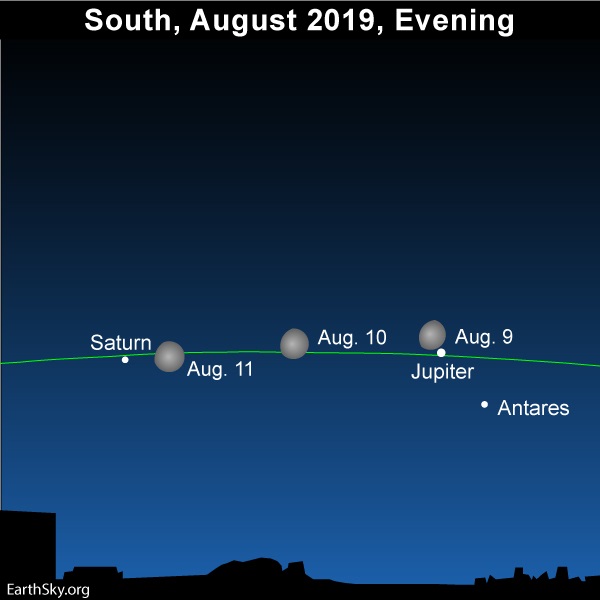
The nearly-full waxing gibbous moon will swing by the planets Jupiter and Saturn on August 9, 10 and 11, 2019. Read more.
Saturn reached its yearly opposition about a month behind Jupiter, on July 9, 2019. So you know these two worlds must be near each other in our sky. At opposition, Saturn rose in the east around sunset, climbed highest up for the night at midnight (midway between sunset and sunrise) and set in the west around sunrise. Like Jupiter now – since it’s still so near its time of opposition – Saturn is nearly at its brightest. Like Jupiter – since opposition came a few weeks back – Saturn is now rising shortly before sunset.
In August 2019, you can see Saturn pop out in the eastern part of the sky first thing at nightfall. This golden world still shines more brilliantly than a 1st-magnitude star, and, even now, stays out for most of the night. Around the world, Saturn sets at about the time of dawn’s first light (astronomical twilight) in early August. Want to know when astronomical twilight starts in your part of the world? Click here and remember to check the astronomical twilight box.
Viewing Saturn’s rings soon? Read me 1st
By the month’s end, at mid-northern latitudes, Saturn is highest in the east at nightfall and sets about one hour after midnight. This is happening because Earth is fleeing ahead of Saturn now, in the race of the planets around the sun.
By the end of the month at temperate latitudes in the Southern Hemisphere, Saturn sets about 3 hours after the midnight hour.
You won’t mistake Jupiter for Saturn. Jupiter is brighter than Saturn. Jupiter is the fourth-brightest celestial object after the sun, moon and Venus, respectively, and it outshines Saturn by a good 10 times. What’s more, at nightfall and early evening in August 2019, Jupiter shines well to the west of Saturn.
Watch for the bright moon to couple up with Saturn on or near August 11, as shown on the sky chart above. If you’re in just the right spot in eastern Australia or northern New Zealand, you can actually watch the moon occult (cover over) Saturn for a portion of the night on August 11-12, 2019.
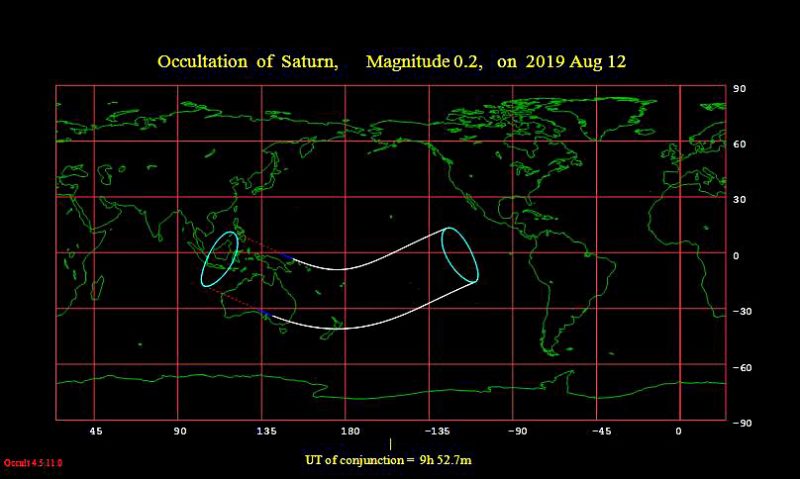
The occultation of Saturn happens in a nighttime sky in between the white lines, at dusk in between the blue lines, and in a daytime sky in between the dotted red lines. Worldwide map via IOTA.
We give the local times for the occultation for two localities:
Sydney, Australia (August 12, 2019)
Occultation begins (Saturn disappears): 6:34 p.m. local time
Occultation ends (Saturn reappears): 7:23 p.m. local time
Auckland, New Zealand (August 12, 2019)
Occultation begins (Saturn disappears): 9:16 p.m. local time
Occultation ends (Saturn reappears): 10:15 p.m. local time
Click here for the occultation times for numerous localities but remember to convert Universal Time to local time. Here’s how.
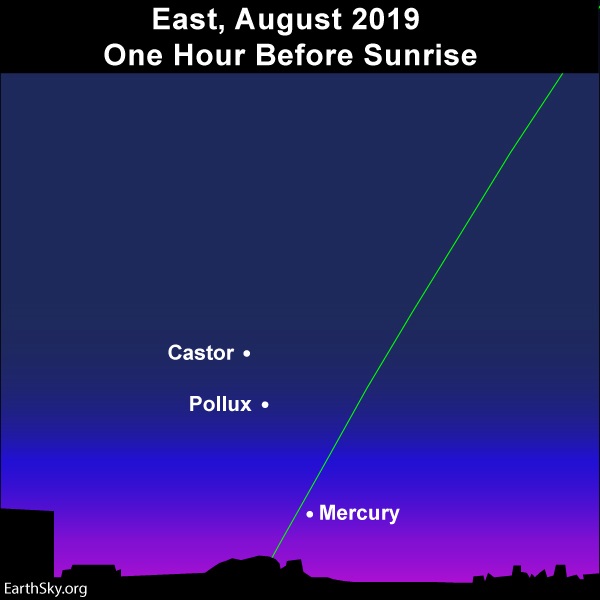
On or near August 11, 2019, the planet Mercury lines up with the Gemini stars, Castor and Pollux. Appreciably before that date, Mercury is still found near the ecliptic but to the west (right) of the Castor-Pollux line. Read more.
Mercury swept more or less in front of the sun at inferior conjunction on July 21, 2019, thereby transitioning out of the evening sky and into the morning sky. It’ll be a morning object all throughout August, yet this faint world will be rather hard to see in the early part of the month. Mercury’s waxing phase will cause this world to brighten dramatically all month long, but Mercury will sink too close to the sun to be visible during the final week of August.
Try catching Mercury an hour or more before sunrise, starting at the end of the first week of August. It should remain in pretty good view in the morning sky for another two weeks after that. Remember that binoculars always come in handy for any Mercury quest, since the solar system’s innermost planet oftentimes has to contend with the glow of twilight.
By the way, at Mercury’s most recent inferior conjunction on July 21, 2019, Mercury swung to the south of the sun’s disk as seen from Earth. But when Mercury reaches its next inferior conjunction on November 11, 2019, the innermost planet will swing directly in front of the sun, to stage a transit of Mercury. Transits of Mercury happen more frequently than transits of Venus; they happen 13 or 14 times per century. The last transit of Mercury happened on May 9, 2016, and – after the one on this upcoming November 11 – the next Mercury transit won’t be until November 13, 2032.

Here’s a superior conjunction. The planet sweeps behind the sun as seen from Earth. Image via COSMOS.
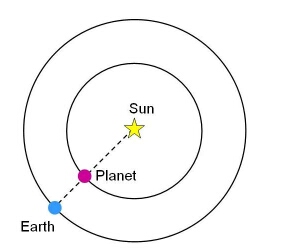
Here’s an inferior conjunction. The planet sweeps between the Earth and sun. As seen from Earth, only Venus and Mercury can have inferior conjunctions. Image via COSMOS.
Where is Venus? The brightest planet must contend with the sun’s glare throughout late July and August 2019. Venus begins August in the glare of sunrise and ends the month in the glare of sunset. In other words – on August 14, 2019 – Venus will reach superior conjunction, as it swings behind the sun in Earth’s sky. Superior conjunction for Venus marks the time of its transition from the morning to evening sky. Most of us will probably first see Venus as a bright evening “star” in the western sky after sunset in September or October 2019.
As seen from above the solar system, Venus is fleeing far ahead of Earth in the race of the planets around the sun. It has gotten so far ahead that it’s essentially “turned the corner” in front of us, so that the sun is now between us and Venus.
Where is Mars? The red planet sits way too close to the afterglow of sunset to be visible in August 2019. It’ll swing on the far side of the sun at superior conjunction on September 2, 2019, to transition from the evening to morning sky. For about six weeks or so on either side of that date, Mars is pretty much absent from our sky, hiding in the sun’s glare.
Look for Mars to return to visibility in the eastern sky before sunrise in November 2019.
What do we mean by bright planet? By bright planet, we mean any solar system planet that is easily visible without an optical aid and that has been watched by our ancestors since time immemorial. In their outward order from the sun, the five bright planets are Mercury, Venus, Mars, Jupiter and Saturn. These planets actually do appear bright in our sky. They are typically as bright as – or brighter than – the brightest stars. Plus, these relatively nearby worlds tend to shine with a steadier light than the distant, twinkling stars. You can spot them, and come to know them as faithful friends, if you try.

Skywatcher, by Predrag Agatonovic.
Bottom line: In late July and August 2019, two planets – Jupiter and Saturn – are easy to see throughout the month. They both come out at nightfall and are out till late night. Mercury appears in the east before sunrise. Mars is lost in the afterglow of sunset, whereas Venus swings behind the sun, to transition from the morning to evening sky. Click here for recommended almanacs; they can help you know when the planets rise and set in your sky.
Don’t miss anything. Subscribe to EarthSky News by email
Visit EarthSky’s Best Places to Stargaze, and recommend a place we can all enjoy. Zoom out for worldwide map.
Help EarthSky keep going! Donate now.
Post your planet photos at EarthSky Community Photos
from EarthSky https://ift.tt/1YD00CF

Click the name of a planet to learn more about its visibility in August 2019: Venus, Jupiter, Saturn, Mars and Mercury.
Jupiter – the second-brightest planet after Venus – reigns supreme in the late July and August 2019 night sky. With Venus lost in the sun’s glare now, dazzling Jupiter – the second-brightest planet after Venus – rules the night. It pops out at dusk – brighter than any star – and stays out until late night. Not sure which one is Jupiter? See the moon in Jupiter’s vicinity for several days, centered on or near August 9.
Jupiter’s yearly opposition was June 10, 2019. Then the planet was opposite the sun, rising at sunset, lighting up the night sky from dusk until dawn. Now, since Jupiter is already well up when night begins, it doesn’t stay out until dawn. From around the world in early August, Jupiter sets in the wee morning hours.
By the month’s end, at mid-northern latitudes, Jupiter will set around midnight (1 a.m. daylight time). By midnight, we mean the middle of the night, or midway between sunset and sunrise.
By the end of the month at temperate latitudes in the Southern Hemisphere, Jupiter will set about one hour after the midnight hour.
That bright ruddy star rather close to Jupiter on our sky’s dome this year is Antares, the Heart of the Scorpion in the constellation Scorpius. In 2019, Jupiter can be seen to “wander” relative to this zodiac star. In other words, in the first three months of 2019, Jupiter was traveling eastward, away from Antares. But starting on April 10, 2019, Jupiter appeared to reverse course, moving toward Antares. For four months (April 10 to August 11, 2019), Jupiter will be traveling in retrograde (or westward), closing the gap between itself and the star Antares. Midway through this retrograde – on June 10, 2019 – Jupiter reached opposition.

The nearly-full waxing gibbous moon will swing by the planets Jupiter and Saturn on August 9, 10 and 11, 2019. Read more.
Saturn reached its yearly opposition about a month behind Jupiter, on July 9, 2019. So you know these two worlds must be near each other in our sky. At opposition, Saturn rose in the east around sunset, climbed highest up for the night at midnight (midway between sunset and sunrise) and set in the west around sunrise. Like Jupiter now – since it’s still so near its time of opposition – Saturn is nearly at its brightest. Like Jupiter – since opposition came a few weeks back – Saturn is now rising shortly before sunset.
In August 2019, you can see Saturn pop out in the eastern part of the sky first thing at nightfall. This golden world still shines more brilliantly than a 1st-magnitude star, and, even now, stays out for most of the night. Around the world, Saturn sets at about the time of dawn’s first light (astronomical twilight) in early August. Want to know when astronomical twilight starts in your part of the world? Click here and remember to check the astronomical twilight box.
Viewing Saturn’s rings soon? Read me 1st
By the month’s end, at mid-northern latitudes, Saturn is highest in the east at nightfall and sets about one hour after midnight. This is happening because Earth is fleeing ahead of Saturn now, in the race of the planets around the sun.
By the end of the month at temperate latitudes in the Southern Hemisphere, Saturn sets about 3 hours after the midnight hour.
You won’t mistake Jupiter for Saturn. Jupiter is brighter than Saturn. Jupiter is the fourth-brightest celestial object after the sun, moon and Venus, respectively, and it outshines Saturn by a good 10 times. What’s more, at nightfall and early evening in August 2019, Jupiter shines well to the west of Saturn.
Watch for the bright moon to couple up with Saturn on or near August 11, as shown on the sky chart above. If you’re in just the right spot in eastern Australia or northern New Zealand, you can actually watch the moon occult (cover over) Saturn for a portion of the night on August 11-12, 2019.

The occultation of Saturn happens in a nighttime sky in between the white lines, at dusk in between the blue lines, and in a daytime sky in between the dotted red lines. Worldwide map via IOTA.
We give the local times for the occultation for two localities:
Sydney, Australia (August 12, 2019)
Occultation begins (Saturn disappears): 6:34 p.m. local time
Occultation ends (Saturn reappears): 7:23 p.m. local time
Auckland, New Zealand (August 12, 2019)
Occultation begins (Saturn disappears): 9:16 p.m. local time
Occultation ends (Saturn reappears): 10:15 p.m. local time
Click here for the occultation times for numerous localities but remember to convert Universal Time to local time. Here’s how.

On or near August 11, 2019, the planet Mercury lines up with the Gemini stars, Castor and Pollux. Appreciably before that date, Mercury is still found near the ecliptic but to the west (right) of the Castor-Pollux line. Read more.
Mercury swept more or less in front of the sun at inferior conjunction on July 21, 2019, thereby transitioning out of the evening sky and into the morning sky. It’ll be a morning object all throughout August, yet this faint world will be rather hard to see in the early part of the month. Mercury’s waxing phase will cause this world to brighten dramatically all month long, but Mercury will sink too close to the sun to be visible during the final week of August.
Try catching Mercury an hour or more before sunrise, starting at the end of the first week of August. It should remain in pretty good view in the morning sky for another two weeks after that. Remember that binoculars always come in handy for any Mercury quest, since the solar system’s innermost planet oftentimes has to contend with the glow of twilight.
By the way, at Mercury’s most recent inferior conjunction on July 21, 2019, Mercury swung to the south of the sun’s disk as seen from Earth. But when Mercury reaches its next inferior conjunction on November 11, 2019, the innermost planet will swing directly in front of the sun, to stage a transit of Mercury. Transits of Mercury happen more frequently than transits of Venus; they happen 13 or 14 times per century. The last transit of Mercury happened on May 9, 2016, and – after the one on this upcoming November 11 – the next Mercury transit won’t be until November 13, 2032.

Here’s a superior conjunction. The planet sweeps behind the sun as seen from Earth. Image via COSMOS.

Here’s an inferior conjunction. The planet sweeps between the Earth and sun. As seen from Earth, only Venus and Mercury can have inferior conjunctions. Image via COSMOS.
Where is Venus? The brightest planet must contend with the sun’s glare throughout late July and August 2019. Venus begins August in the glare of sunrise and ends the month in the glare of sunset. In other words – on August 14, 2019 – Venus will reach superior conjunction, as it swings behind the sun in Earth’s sky. Superior conjunction for Venus marks the time of its transition from the morning to evening sky. Most of us will probably first see Venus as a bright evening “star” in the western sky after sunset in September or October 2019.
As seen from above the solar system, Venus is fleeing far ahead of Earth in the race of the planets around the sun. It has gotten so far ahead that it’s essentially “turned the corner” in front of us, so that the sun is now between us and Venus.
Where is Mars? The red planet sits way too close to the afterglow of sunset to be visible in August 2019. It’ll swing on the far side of the sun at superior conjunction on September 2, 2019, to transition from the evening to morning sky. For about six weeks or so on either side of that date, Mars is pretty much absent from our sky, hiding in the sun’s glare.
Look for Mars to return to visibility in the eastern sky before sunrise in November 2019.
What do we mean by bright planet? By bright planet, we mean any solar system planet that is easily visible without an optical aid and that has been watched by our ancestors since time immemorial. In their outward order from the sun, the five bright planets are Mercury, Venus, Mars, Jupiter and Saturn. These planets actually do appear bright in our sky. They are typically as bright as – or brighter than – the brightest stars. Plus, these relatively nearby worlds tend to shine with a steadier light than the distant, twinkling stars. You can spot them, and come to know them as faithful friends, if you try.

Skywatcher, by Predrag Agatonovic.
Bottom line: In late July and August 2019, two planets – Jupiter and Saturn – are easy to see throughout the month. They both come out at nightfall and are out till late night. Mercury appears in the east before sunrise. Mars is lost in the afterglow of sunset, whereas Venus swings behind the sun, to transition from the morning to evening sky. Click here for recommended almanacs; they can help you know when the planets rise and set in your sky.
Don’t miss anything. Subscribe to EarthSky News by email
Visit EarthSky’s Best Places to Stargaze, and recommend a place we can all enjoy. Zoom out for worldwide map.
Help EarthSky keep going! Donate now.
Post your planet photos at EarthSky Community Photos
from EarthSky https://ift.tt/1YD00CF


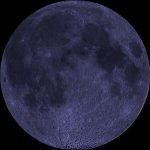
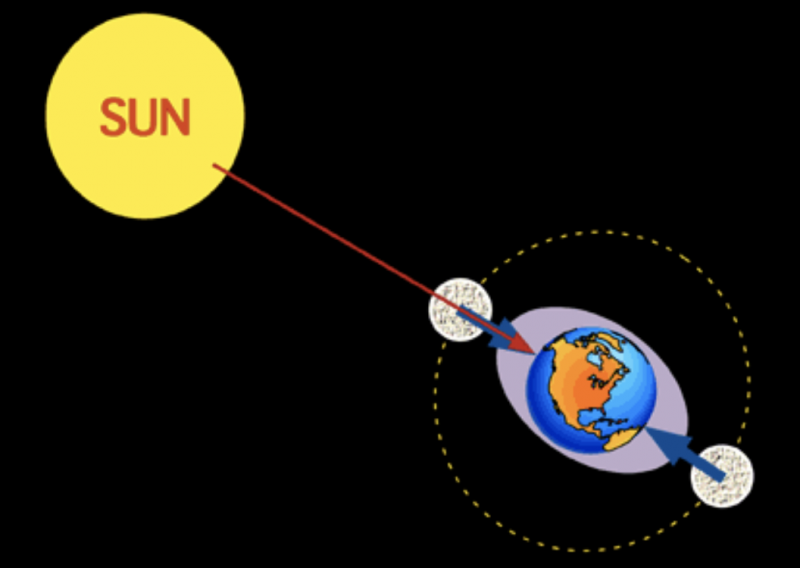




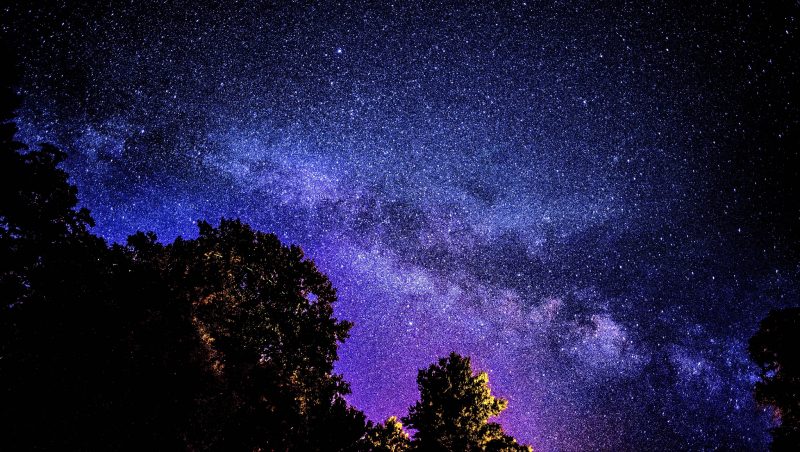

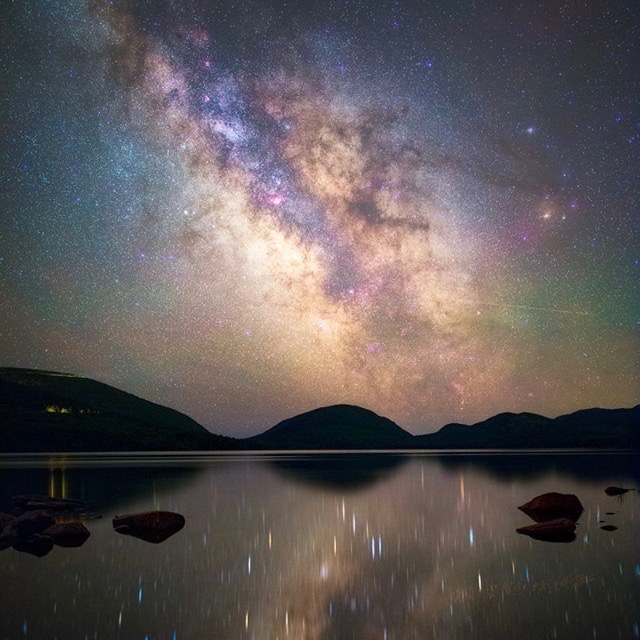
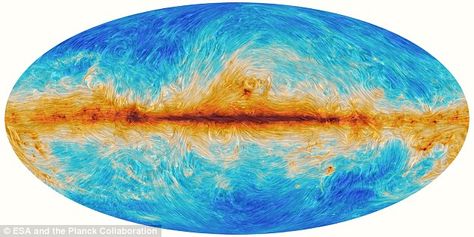



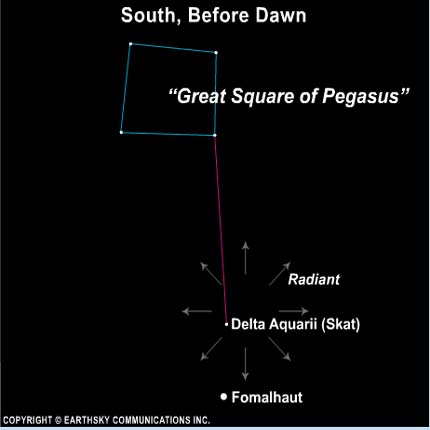

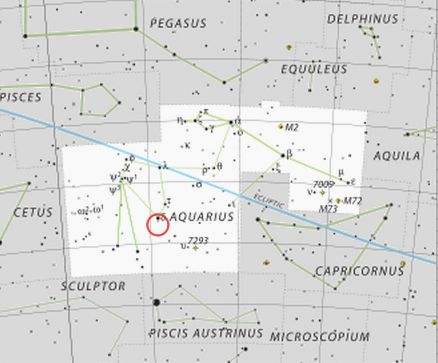

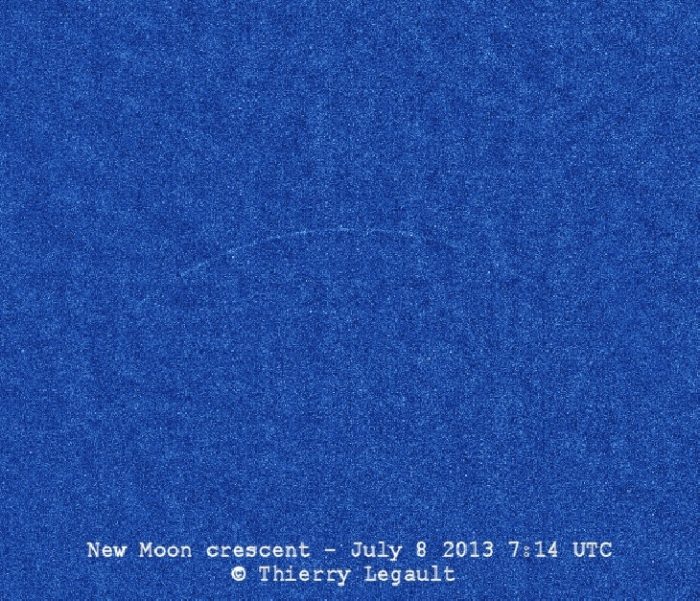
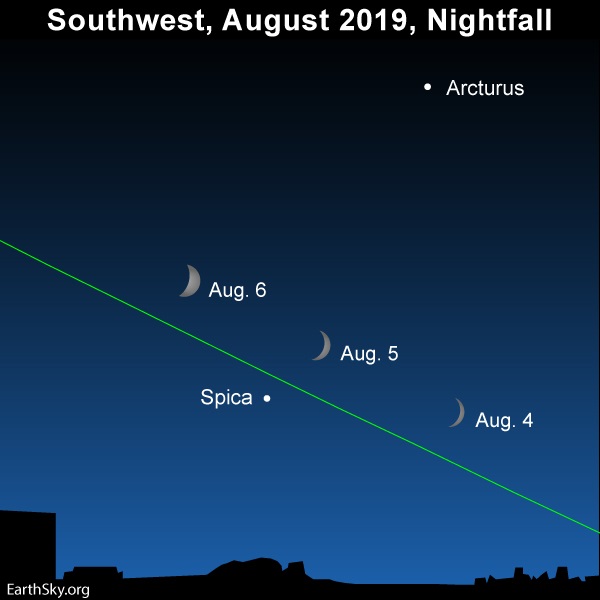


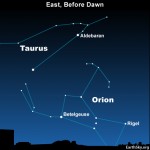



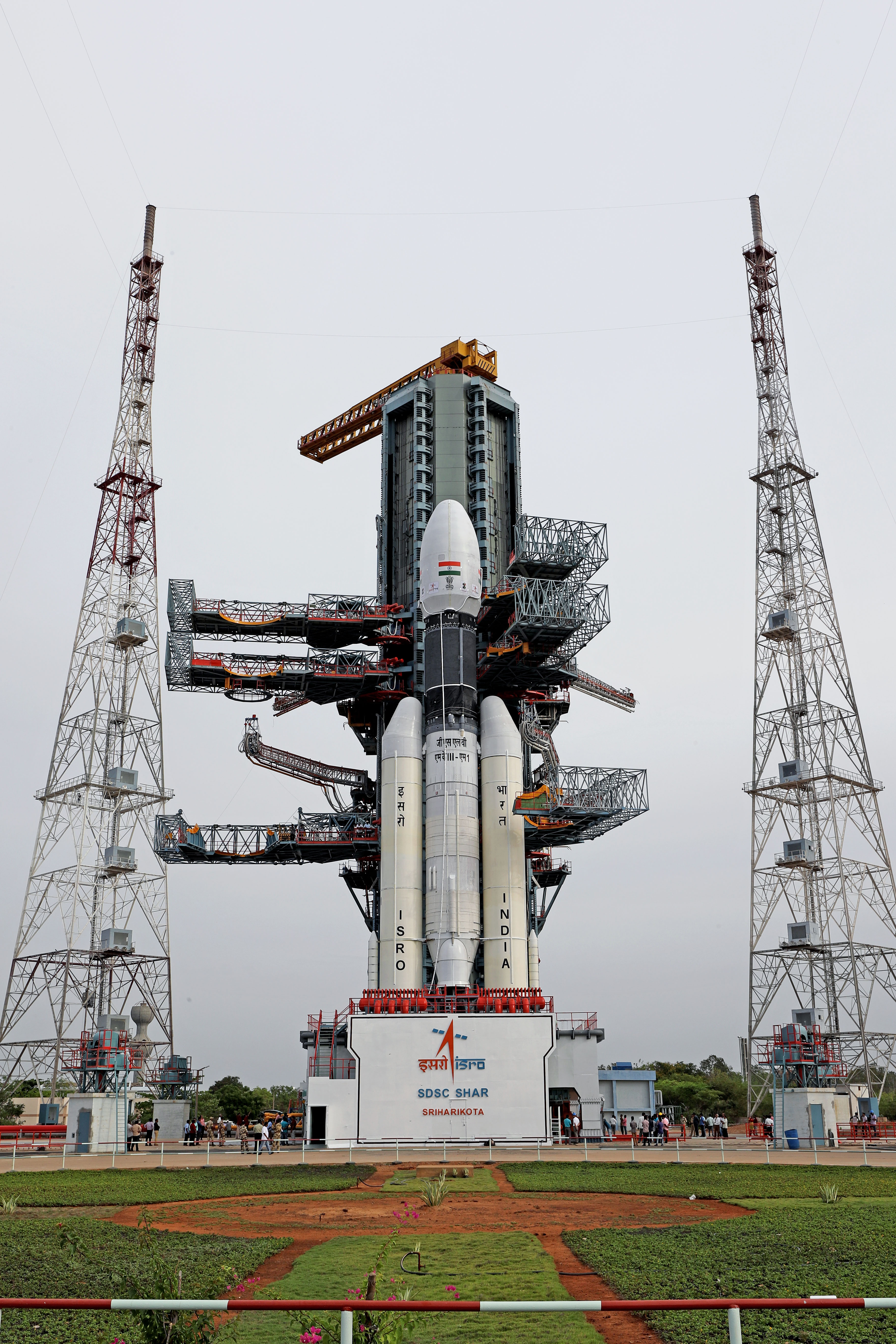


 The moon will meet up with the king planet Jupiter on or near August 9, 2019.
The moon will meet up with the king planet Jupiter on or near August 9, 2019.



